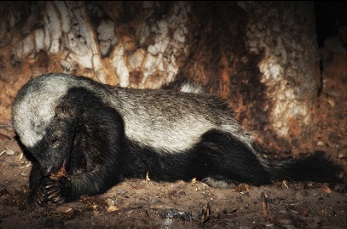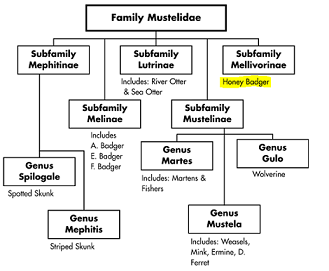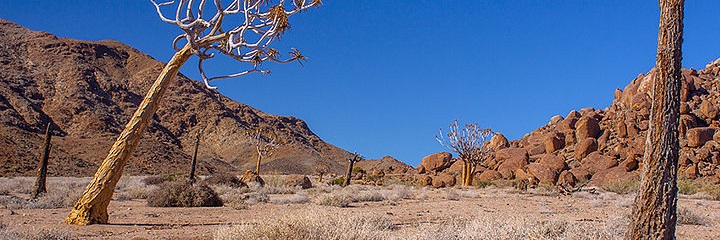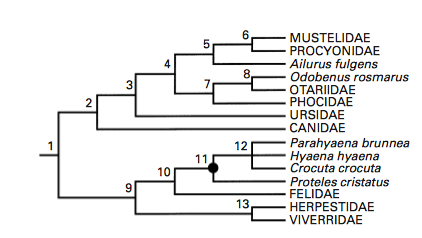Classification - Where Do I fit in?
Mellivora capensis, the scientific name of the honey badger, means honey eater of the Cape in english terminology. The Cape refers to a specific region of Southern Africa where the honey badger can be found (Begg, 2012). Through observations of the honey badger's phylogeny, it is clear that it comes from a relatively diverse ancestry, leading to this special species.
Domain: Eukarya
To belong to the Domain Eukarya, it requires that the organisms
contain membrane bound nuclei within their cells. This differs from
Prokaryotes and Archaea since their DNA material is not housed
within a membrane. Learn more about the diversification of the
Eukarya by following this
link.
Kingdom: Animalia
Due to the great diversity related to the Animalia kingdom, it is
generally difficult to characterize them all as one. Animal cells do
not have a rigid cell wall in contrast to the Plantae and Fungi
kingdoms that have cell walls (either consisting of chitin or
cellulose) and generally obtain their energy by consuming other
organisms (through ingestion). This is different from a majority of
the Plantae species that in most cases create their own energy via
photosynthesis. (Encyclopedia of Life, 2014)

Phylum: Chordata
Members of the Phylum Chordata can be found on both land and in sea,
though they include a relatively diverse range of species. Species
that fit into this phylum all have a spinal chord that stems from
the brain to relay information throughout the organism. This spinal
chord is generally protected by a series of vertebrae to protect the
nervous tissue. (Encyclopedia of Life, 2014)
Class: Mammalia
Organisms that fall into the Mammalian Class are vertebrate animals
that in most cases are warm-blooded individuals. Species in this
class feed their offspring with milk that is produced in the
mother’s mammary glands. Mammal species generally have various
abilities such as swimming, running, climbing, and flying as well.
(Encyclopedia of Life, 2014)
Order: Carnivora
In the Carnivora order, there is a relatively smaller range of
species, including 281 different types across 128 genera. Species of
this order are generally referred to as carnivores, meaning
“meat-eating”. The main way that carnivores obtain their energy
resources is by preying on different types of species, either
herbivores or smaller types of carnivores. (Encyclopedia of Life,
2014)
The phylogenic tree displayed below shows the distribution of different families within the Carnivora Order. The honey badger is a part of the Mustelidae family which is located after the MRCA 6. This tree shows how the species that are a part of the Mustelidae show much genetic variation in relation to the other species within the Carnivora. The Procyonidae are its closests relatives which consist of racoon like species (Encyclopedia of Life, 2014).
Family: Mustelidae
The Mustelidae family is considered the largest family within the
order of Carnivora, consisting of weasels and similar species. These
species can be found on almost every continent besides Australia and
Antarctica. The Mustelidae have varius forms of species within their
taxonomy and position within each genus is up to debate. This family
consists of mammals generally smaller of size with
weasel/ferret like
features. (Encyclopedia of Life, 2014)
This phylogenic tree shows how the Mellivora
Genus/Subfamily is distributed within the Mustelidae family.
From observations of the tree, it can be seen that the Mellivorina
is one of 5 sub-categories of the Mustelidae. In contrast to
the other families, the honey badger is the only species within its
sub-category apart from various
skunks or weasels. This means that at some point the honey badger
must have diverged seperately from its "cousins", maintaining
evolutionary success.
Genus: Mellivora
In order for a species to be classified under the genus, the species
must be of an animal that typically feeds on honey. Mellivora is a
Latin term for this characteristic derived from the Latin word
“mellivorous”. The honey badger is the only species within this
genus. (Reverso Dictionary, 2014)
Species: capensis
The species name capensis is the specific name related to the honey
badger. In combination with Mellivora, it means a badger that
typically feeds on honey. (Encyclopedia of Life, 2014)
To discover where geographically the honey badger fits in, take a look at the Habitat and Geography page!

